

What makes a group worth dying for? Ident... [J Pers Soc Psychol. 2014] Does 'Could' Lead to Good? Toward a Theory of Moral Insight by Ting Zhang, Francesca Gino, Joshua D. Margolis. Ting Zhang Harvard Business School Francesca Gino Harvard University - Harvard Business School Joshua D.

Margolis Harvard UniversityJune 2, 2014 Harvard Business School NOM Unit Working Paper No. 14-118 Harvard Business School Organizational Behavior Unit Working Paper No. 14-118 Abstract: We introduce the construct of moral insight and study how it can be elicited when people face ethical dilemmas—challenging decisions that feature tradeoffs between competing and seemingly incompatible values. Number of Pages in PDF File: 52 Keywords: Moral insight, Ethical dilemma, Could mindset, Creativity, Divergent thinking working papers series Suggested Citation Zhang, Ting and Gino, Francesca and Margolis, Joshua D., Does 'Could' Lead to Good? Worldwide, Many See Belief in God as Essential to Morality.
Richer Nations Are Exception Survey Report Updated May 27, 2014.

Cognition from the bottom up: on biological inspiration, body morphology, and soft materials. Highlights We discuss the connection between cognition, body morphology, and material properties.
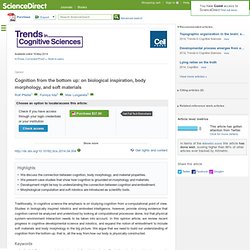
We present case studies that show how cognition is grounded on morphology and materials. Development might be key to understanding the connection between cognition and embodiment. Morphological computation and soft robotics are introduced as scientific tools. Traditionally, in cognitive science the emphasis is on studying cognition from a computational point of view. Identification of the hikikomori syndro... [Int J Soc Psychiatry. 2014] Oral approach-avoidance: Affective conseq... [J Pers Soc Psychol. 2014] Third-party punishment increases cooperation in children through (misaligned) expectations and conditional cooperation. Author Affiliations Edited by Jessica C.
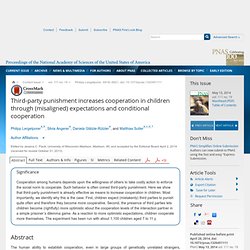
Flack, University of Wisconsin-Madison, Madison, WI, and accepted by the Editorial Board April 2, 2014 (received for review October 31, 2013) Significance Cooperation among humans depends upon the willingness of others to take costly action to enforce the social norm to cooperate. Lifting the Veil of “Islamophobia” : A Conversation with Ayaan Hirsi Ali. (Photo via Getty Images) Ayaan Hirsi Ali was born in Mogadishu in 1969.
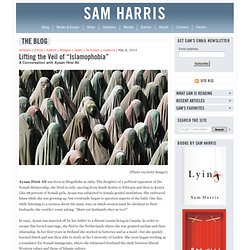
The daughter of a political opponent of the Somali dictatorship, she lived in exile, moving from Saudi Arabia to Ethiopia and then to Kenya. Like 98 percent of Somali girls, Ayaan was subjected to female genital mutilation. She embraced Islam while she was growing up, but eventually began to question aspects of the faith. One day, while listening to a sermon about the many ways in which women must be obedient to their husbands, she couldn’t resist asking, “Must our husbands obey us too?” In 1992, Ayaan was married off by her father to a distant cousin living in Canada. After earning her M.A. in political science, Ayaan began working as a researcher for the Wiardi Beckman Foundation in Amsterdam. In 2004, Ayaan gained international attention following the murder of Theo van Gogh, who had directed her short film, Submission, depicting the oppression of women under Islam.
Continuously Cumulating Meta-Analysis and Replicability. Electrophysiology of Intuition: Pre-stim... [Glob Adv Health Med. 2014. Psychiatry's scientific reboot gets under way - health - 07 May 2014. Read full article Continue reading page |1|2 IMAGINE you are a doctor before the advent of modern medical tests and your patient is gasping for breath.

Is it asthma, a chest injury, or are they having a heart-attack? You don't know and have no idea how best to help them. Some would argue that's what it's like for doctors trying to diagnose mental health problems today. The issue came to a head one year ago this month, with the latest edition of psychiatry's "bible", the Diagnostic and Statistical Manual of Mental Disorders. That research is now taking off. While just a first draft, the list arguably represents the future of neuroscience-based mental healthcare. I don’t deserve to be this happy: Dampening of positive feelings found to predict postpartum depressive symptoms. A new KU Leuven study shows for the first time that the dampening or suppression of positive emotions plays an important role in the development of postpartum depression.
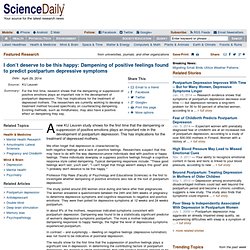
This has implications for the treatment of depressed mothers. We often forget that depression is characterized by both negative feelings and a lack of positive feelings. Researchers suspect that this may have to do with the way depression-prone individuals deal with positive or happy feelings. These individuals downplay or suppress positive feelings through a cognitive response style called dampening.
Typical dampening responses include: "These good feelings won't last, you'll see"; "I can't forget that things weren't always this good" and "I probably don't deserve to be this happy. " Dissecting empathy: high levels of psychopathic and autistic traits are characterized by difficulties in different social information processing domains. 1Division of Psychology and Language Sciences, University College London, London, UK2MRC Social, Genetic and Developmental Psychiatry Centre, Institute of Psychiatry, Kings College London, London, UK3Institute of Cognitive Neuroscience, University College London, London, UK Individuals with psychopathy or autism spectrum disorder (ASD) can behave in ways that suggest lack of empathy towards others.
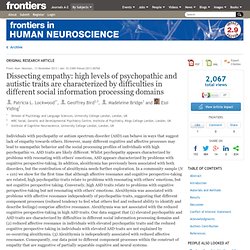
However, many different cognitive and affective processes may lead to unempathic behavior and the social processing profiles of individuals with high psychopathic vs. ASD traits are likely different. Cortisol Increase in Empathic Stress is modulated by Social Closeness and Observation Modality. Abstract Stress disorders are among the most commonly occurring of all mental disorders.

In this context, the question arises whether the stress inevitably unfolding around us has the potential to “contaminate” and compromise us. In the current multi-center study, we investigate the existence of such empathic stress (defined as a full-blown physiological stress response that arises solely by observing a target undergo a stressful situation), and whether empathic stress permeates to the core of the stress system, the hypothalamic-pituitary-adrenal (HPA) axis. Additionally, we investigate whether empathic stress responses may be modulated by the familiarity between observer and target (partners vs. strangers), the modality of observation (real-life vs. virtual) and observer sex (female vs. male).
Participants were tested in dyads, paired with a loved one or a stranger of the opposite sex. Keywords. Using A Foreign Language Influences Your Sense of Morality. 14 Flares Twitter 9 Facebook 0 Reddit 1 StumbleUpon 1 LinkedIn 0 inShare0 Google+ 3 14 Flares × In an other language you make different moral choices.
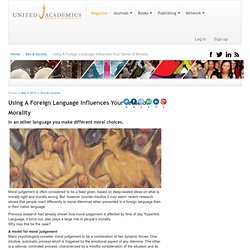
Moral judgement is often considered to be a fixed given, based on deep-seated ideas on what is morally right and morally wrong. But, however counter-intuitive it may seem: recent research shows that people react differently to moral dilemmas when presented in a foreign language than in their native language. Murder or Not? Cold Temperature Makes Criminals App... [PLoS One. 2014. The consciousness state space (CSS)—a unifying model for consciousness and self. Introduction Every human experience, those we are aware of and those we are not, is embedded in a subjective timeline, and is tinged with emotion, be it the subtlest.
At the same time, each experience inevitably evokes a certain sense of self, either minimal (i.e., non-conceptual first-person content, without personal identity) or expanded and autobiographic (i.e., personal identity and continuity across time). A Common Cortical Metric for Spatial, Temporal, and Social Distance. Carolyn Parkinson, Shari Liu, and Thalia Wheatley +Show Affiliations Author contributions: C.P. and T.W. designed research; C.P. and S.L. performed research; C.P. analyzed data; C.P. and T.W. wrote the paper. The Journal of Neuroscience, 29 January 2014, 34(5): 1979-1987; doi: 10.1523/JNEUROSCI.2159-13.2014. The Rough Guide to the Blog. Self-Interest Bias in Moral Judgments ... [Pers Soc Psychol Bull. 2014. Differences in HPA-axis and Heart Rate Responsiveness to Psychosocial Stress in Children with Autism Spectrum Disorders with and without co-morbid anxiety.
Abstract Children and adolescents with autism spectrum disorder (ASD) have much higher rates of anxiety disorders relative to their typically developing peers. However, there have been few attempts to investigate what physiological parameters may be associated with this elevated rate of anxiety. Therefore, this study investigated the physiological correlates of anxiety in ASD, with a focus on whether measures of heart rate and cortisol responsiveness to psychosocial stress differentiate those participants with ASD with and without a co-occurring anxiety disorder. A total of 75 male participants aged 10 to 16 years with normal intellectual ability underwent a psychosocial stress test. The participants included healthy controls (n = 23), ASD only (ASD; n = 20) and ASD with a comorbid anxiety disorder (ASDanx; n = 32).
Keywords Autistic Disorder; Cortisol; Developmental Disorders; Emotion; Mood Disorders Copyright © 2014 Elsevier Ltd. Boosting depression-causing mechanisms in brain increases resilience, surprisingly. A new study points to a conceptually novel therapeutic strategy for treating depression. Instead of dampening neuron firing found with stress-induced depression, researchers demonstrated for the first time that further activating these neurons opens a new avenue to mimic and promote natural resilience.
The findings were so surprising that the research team thinks it may lead to novel targets for naturally acting antidepressants. Results from the study are published online April 18 in the journal Science. Social Reward Questionnaire (SRQ): development and validation. 1Developmental Risk and Resilience Unit, Division of Psychology and Language Sciences, University College London, London, UK2Department of Psychology, University of North Texas, Texas, TX, USA Human beings seek out social interactions as a source of reward.
To date, there have been limited attempts to identify different forms of social reward, and little is known about how the value of social rewards might vary between individuals. How politics makes us stupid. The social circuits that track how we like people and ideas. Cognitive Neuroscience Society » Poster Guidelines. Free to punish: A motivated account of fr... [J Pers Soc Psychol. 2014. Living with Williams Syndrome, the 'opposite of autism' 7 April 2014Last updated at 07:46 ET By Pippa Stephens Health reporter, BBC News Chris Steel says he is happiest when he is acting, as he "wants to show people what he can do" Twenty-two emotions are written on our faces.
Human faces just got a lot more emotional. People can broadcast more than three times as many different feelings on their faces as scientists once suspected. For years, scientists have thought that people could convey only happiness, surprise, sadness, anger, fear and disgust. Did Hyman Minsky find the secret behind financial crashes? 23 March 2014Last updated at 21:14 ET American economist Hyman Minsky, who died in 1996, grew up during the Great Depression, an event which shaped his views and set him on a crusade to explain how it happened and how a repeat could be prevented, writes Duncan Weldon. Brian Leiter's Nietzsche Blog. Edge.org. One idea in the study of emotion and its impact on psychological health is overdue for retirement: that negative emotions (like sadness or fear) are inherently bad or maladaptive for our psychological well-being, and positive emotions (like happiness or joy) are inherently good or adaptive.
Such value judgments are to be understood, within the framework of affective science, as depending on whether an emotion impedes or fosters a person's ability to pursue goals, attain resources, and function effectively within society. Human Connectome Project Suicide is widely deemed immoral because it 'taints the soul,' study shows.
New Years: A time for a little evidence based self-evaluation (CC: Boris Johnson) Science Confirms: Politics Wrecks Your Ability to Do Math. A new study finds that even how you solve a difficult math problem can depend on your politics.AlenKadr/Shutterstock Everybody knows that our political views can sometimes get in the way of thinking clearly. Patter’s 2013 top ten. The Interactive Effect of Anger and Disgust on Moral Outrage and Judgments. Data sharing not only helps facilitate the process of psychology research, it is also a reflection of rigour. Bayesian Versus Orthodox Statistics: Which Side Are You On? Emotions in “the world”: cultural practices, products, and meanings of anger and shame in two individualist cultures.
The Liberal Illusion of Uniqueness. The Ways of Lust. Experiencing Awe Increases Belief in the Supernatural. On the embodiment of emotion regulation: interoceptive awareness facilitates reappraisal. What are you scared of? - Press Release - Different brain regions process different types of fear. University of Roehampton - Ethics Forms.
Decoding Visual Object Categories in Early Somatosensory Cortex. Joshua Greene’s Moral Tribes Reviewed by Thomas Nagel. Physical effort fuels a feeling of ownership over our movements. Study reveals people physically take pleasure in others' pain. A study of suicide notes left by children and young teens. People make more moral decisions when they think their heart is racing. Morality Quiz/Test your Morals, Values & Ethics - Your Morals.Org. Turning Body and Self Inside Out. When do negative emotions give you an edge in negotiations? The embodiment of emotion: language use during the feeling of social emotions predicts cortical somatosensory activity.
Current Biology - Negative Emotional Outcomes Attenuate Sense of Agency over Voluntary Actions. Identification of discrete function... [Proc Natl Acad Sci U S A. 2013. Interoceptive awareness moderates neural activity during decision-making. Embedding and Publishing Interactive, 3-Dimensional, Scientific Figures in Portable Document Format (PDF) Files. The Smarter We Are, the Dumber We Get About Facts. Free will debate: What does free will mean and how did it evolve? Unaware Person Recognition From the Body When Face Identification Fails.
The role of anterior midcingulate cortex in cognitive motor control - Hoffstaedter - 2013 - Human Brain Mapping. Emotional Processing of Personally Familiar Faces in the Vegetative State. Right Supramarginal Gyrus Is Crucial to Overcome Emotional Egocentricity Bias in Social Judgments. Categorical Clustering of the Neural Representation of Color. The functional value of consciousness revealed by cross-modal comparison. The influence of emotions on cognitive control: feelings and beliefs—where do they meet? Coloring In Birds' Bellies with Magic Marker Makes Them Healthier. How does morality work in the brain? A functional and structural perspective of moral behavior. Sustained Striatal Activity Predicts Eudaimonic Well-Being and Cortisol Output. Genes for Emotion-Enhanced Remembering Are Linked to Enhanced Perceiving. Most Influential Emotions on Social Networks Revealed.
Moral disengagement among children and youth: A meta-analytic review of links to aggressive behavior - Gini - 2013 - Aggressive Behavior. Oxytocin Sharpens Self-other Perceptual Boundary. Behavioral Confirmation of Everyday Sadism. The Social Life of Genes: Shaping Your Molecular Composition. Two distinct forms of functional lateralization in the human brain. When Virtue Becomes Vice. The ethology of empathy: a taxonomy of real-world targets of need and their effect on observers. Talking about Emotion: Prosody and Skin Conductance Indicate Emotion Regulation. How the monkey brain assimilates a virtual limb into its body map. Ventromedial prefrontal cortex and the regulation of physiological arousal. Guilt is catching. Just Thinking about Science Triggers Moral Behavior. Of hissing snakes and angry voices: human infants are differentially responsive to evolutionary fear-relevant sounds - Erlich - 2013 - Developmental Science.
Touch and movement neurons shape the brain's internal image of the body. Kids experience schadenfreude by age four, maybe earlier. Improving your health by pursuing meaning in your life versus happiness. Why conservatives are happier than liberals. Cognition–Emotion Integration in the Anterior Insular Cortex. Computing for Psychologists. Metacognition and awareness. [Conscious Cogn. 2000. Models of morality. The human brain encodes event frequenci - PubMed Mobile.
LIWC: Linguistic Inquiry and Word Count. Randomise Me. Randomise Me: how you can set up and run your own trial.